Particle Contamination in Commercial Lithium-Ion Cells—Risk Assessment with Focus on Internal Short Circuits and Replication by Currently Discussed Trigger Methods
Abstract
:1. Introduction
| No. | Name | Description | Refs. |
|---|---|---|---|
| ① | Melting wax layer (phase change material—PCM) |
| [70,71,72,73,74] |
| ② | Low-melting-point alloy |
| [75] |
| ③ | Bi-metal (shape memory alloy—SMA) |
| [22,76] |
| ④ | External force on internal particle (Battery Association of Japan—BAJ) |
| [69,77,78,79] |
| ⑤ | Inserting steel ball externally/blunt rod/IIISC Test |
| [80,81,82,83] |
| ⑥ | Slots in separator and electrode materials |
| [64,80] |
| ⑦ | Penetration: ceramic Nail with Ni tip |
| [68,69,84] |
| ⑧ | Slow penetration with small needle |
| [85,86] |
2. Materials and Methods
2.1. Tensioning
- Significant increase in TR risk if ISC is created at high SOC state [62];
- Losing the opportunity for any ex-situ analysis of realistic particles in case of TR;
- Overall significant effort required for handling the potential TR of large-format (53 Ah) cells.
2.2. Disassembling
2.3. Particle Analysis
3. Results
3.1. Tensioning
3.2. Disassembling and Particle Identification
3.2.1. Particle 2.1
3.2.2. Particle 5.1, 5.2 and 5.3
3.3. Evaluation of All Particles
3.4. Evaluation of Current Trigger Methods for Particle-Induced ISC
4. Conclusions
Author Contributions
Funding
Institutional Review Board Statement
Informed Consent Statement
Data Availability Statement
Acknowledgments
Conflicts of Interest
Abbreviations
| Al | Aluminium |
| An | Anode |
| BAJ | Battery Association of Japan |
| BMS | Battery management system |
| C | Carbon |
| Ca | Cathode |
| Cu | Copper |
| EDX | Energy dispersive X-ray spectroscopy |
| F | Flurine |
| Fe | Iron |
| IIISC | Indentation-induced internal short circuit |
| IRT | Infrared thermography |
| ISC | Internal short circuit |
| Lithium cobalt oxide | |
| Mg | Magnesium |
| Ni | Nickel |
| NMC | Nickel manganese cobalt |
| PCM | Phase change material |
| P | Phosphorus |
| PHEV | Plug-in hybrid electric vehicle |
| PTFE | Polytetrafluoroethylene |
| SEM | Scanning electron microscopy |
| Si | Silicon |
| SEI | Solid electrolyte interphase |
| SOC | State of charge |
| SOH | State of health |
| TP | Thermal propagation |
| TR | Thermal runaway |
| Sn/Bi/In | Tin/bismuth/indium |
| Ti | Titanium |
References
- Zubi, G.; Dufo-López, R.; Carvalho, M.; Pasaoglu, G. The lithium-ion battery: State of the art and future perspectives. Renew. Sustain. Energy Rev. 2018, 89, 292–308. [Google Scholar] [CrossRef]
- Tidblad, A.A.; Edström, K.; Hernández, G.; de Meatza, I.; Landa-Medrano, I.; Jacas Biendicho, J.; Trilla, L.; Buysse, M.; Ierides, M.; Horno, B.P.; et al. Future Material Developments for Electric Vehicle Battery Cells Answering Growing Demands from an End-User Perspective. Energies 2021, 14, 4223. [Google Scholar] [CrossRef]
- Bryntesen, S.N.; Strømman, A.H.; Tolstorebrov, I.; Shearing, P.R.; Lamb, J.J.; Stokke Burheim, O. Opportunities for the State-of-the-Art Production of LIB Electrodes—A Review. Energies 2021, 14, 1406. [Google Scholar] [CrossRef]
- Bravo Diaz, L.; He, X.; Hu, Z.; Restuccia, F.; Marinescu, M.; Barreras, J.V.; Patel, Y.; Offer, G.; Rein, G. Review—Meta-Review of Fire Safety of Lithium-Ion Batteries: Industry Challenges and Research Contributions. J. Electrochem. Soc. 2020, 167, 090559. [Google Scholar] [CrossRef]
- Börger, A.; Mertens, J.; Wenzl, H. Thermal runaway and thermal runaway propagation in batteries: What do we talk about? J. Energy Storage 2019, 24, 100649. [Google Scholar] [CrossRef]
- Federal Aviation Administration. Events with Smoke, Fire, Extreme Heat or Explosion Involving Lithium Batteries. Available online: https://www.faa.gov/sites/faa.gov/files/2022-04/April%201%202022%20Li-Batt.%20Thermal%20Events.pdf (accessed on 7 January 2022).
- Electric Power Research Institute. BESS Failure Event Database: Stationary Energy Storage Failure Events. Available online: https://storagewiki.epri.com/index.php/BESS_Failure_Event_Database (accessed on 5 July 2022).
- Baird, A.R.; Archibald, E.J.; Marr, K.C.; Ezekoye, O.A. Explosion hazards from lithium-ion battery vent gas. J. Power Sources 2020, 446, 227257. [Google Scholar] [CrossRef]
- Essl, C.; Golubkov, A.W.; Gasser, E.; Nachtnebel, M.; Zankel, A.; Ewert, E.; Fuchs, A. Comprehensive Hazard Analysis of Failing Automotive Lithium-Ion Batteries in Overtemperature Experiments. Batteries 2020, 6, 30. [Google Scholar] [CrossRef]
- Ouyang, D.; Liu, J.; Chen, M.; Weng, J.; Wang, J. Thermal Failure Propagation in Lithium-Ion Battery Modules with Various Shapes. Appl. Sci. 2018, 8, 1263. [Google Scholar] [CrossRef] [Green Version]
- Wang, Q.; Mao, B.; Stoliarov, S.I.; Sun, J. A review of lithium ion battery failure mechanisms and fire prevention strategies. Prog. Energy Combust. Sci. 2019, 73, 95–131. [Google Scholar] [CrossRef]
- Feng, X.; Ouyang, M.; Liu, X.; Lu, L.; Xia, Y.; He, X. Thermal runaway mechanism of lithium ion battery for electric vehicles: A review. Energy Storage Mater. 2018, 10, 246–267. [Google Scholar] [CrossRef]
- Chombo, P.V.; Laoonual, Y. A review of safety strategies of a Li-ion battery. J. Power Sources 2020, 478, 228649. [Google Scholar] [CrossRef]
- Klink, J.; Hebenbrock, A.; Grabow, J.; Orazov, N.; Nylén, U.; Benger, R.; Beck, H.P. Comparison of Model-Based and Sensor-Based Detection of Thermal Runaway in Li-Ion Battery Modules for Automotive Application. Batteries 2022, 8, 34. [Google Scholar] [CrossRef]
- Hu, X.; Zhang, K.; Liu, K.; Lin, X.; Dey, S.; Onori, S. Advanced Fault Diagnosis for Lithium-Ion Battery Systems: A Review of Fault Mechanisms, Fault Features, and Diagnosis Procedures. IEEE Ind. Electron. Mag. 2020, 14, 65–91. [Google Scholar] [CrossRef]
- Chen, Y.; Kang, Y.; Zhao, Y.; Wang, L.; Liu, J.; Li, Y.; Liang, Z.; He, X.; Li, X.; Tavajohi, N.; et al. A review of lithium-ion battery safety concerns: The issues, strategies, and testing standards. J. Energy Chem. 2021, 59, 83–99. [Google Scholar] [CrossRef]
- Thakur, A.K.; Prabakaran, R.; Elkadeem, M.R.; Sharshir, S.W.; Arıcı, M.; Wang, C.; Zhao, W.; Hwang, J.Y.; Saidur, R. A state of art review and future viewpoint on advance cooling techniques for Lithium–ion battery system of electric vehicles. J. Energy Storage 2020, 32, 101771. [Google Scholar] [CrossRef]
- Challa, V. How to Prevent Li-Ion Battery Failures. Baltimore (USA). 2018. Available online: https://slideplayer.com/slide/17213977/ (accessed on 1 December 2022).
- Zhang, G.; Wei, X.; Tang, X.; Zhu, J.; Chen, S.; Dai, H. Internal short circuit mechanisms, experimental approaches and detection methods of lithium-ion batteries for electric vehicles: A review. Renew. Sustain. Energy Rev. 2021, 141, 110790. [Google Scholar] [CrossRef]
- Wu, C.; Zhu, C.; Ge, Y.; Zhao, Y. A Review on Fault Mechanism and Diagnosis Approach for Li-Ion Batteries. J. Nanomater. 2015, 2015, 1–9. [Google Scholar] [CrossRef] [Green Version]
- Kong, X.; Lu, L.; Yuan, Y.; Sun, Y.; Feng, X.; Yang, H.; Zhang, F.; Zhang, J.; Liu, X.; Han, X.; et al. Foreign matter defect battery and sudden spontaneous combustion. eTransportation 2022, 12, 100170. [Google Scholar] [CrossRef]
- Liu, L.; Feng, X.; Zhang, M.; Lu, L.; Han, X.; He, X.; Ouyang, M. Comparative study on substitute triggering approaches for internal short circuit in lithium-ion batteries. Appl. Energy 2020, 259, 114143. [Google Scholar] [CrossRef]
- Brodd, R.J. Batteries for Sustainability; Springer: New York, NY, USA, 2013. [Google Scholar] [CrossRef]
- Barnett, B. Lithium-Ion Cell Internal Shorting: 1. Early Detection 2. Simulation: CamXPower; Battery Safety Council Forum: Washington, DC, USA, 2017. [Google Scholar]
- Ceder, G. Opportunities and challenges for material design in LIB. MRS Bull. 2010, 35, 693–701. [Google Scholar] [CrossRef]
- Zhu, R.; Feng, J.; Guo, Z. In Situ Observation of Dendrite Behavior of Electrode in Half and Full Cells. J. Electrochem. Soc. 2019, 166, A1107–A1113. [Google Scholar] [CrossRef]
- Cannarella, J.; Arnold, C.B. The Effects of Defects on Localized Plating in Lithium-Ion Batteries. J. Electrochem. Soc. 2015, 162, A1365–A1373. [Google Scholar] [CrossRef] [Green Version]
- David, L.; Ruther, R.E.; Mohanty, D.; Meyer, H.M.; Sheng, Y.; Kalnaus, S.; Daniel, C.; Wood, D.L. Identifying degradation mechanisms in lithium-ion batteries with coating defects at the cathode. Appl. Energy 2018, 231, 446–455. [Google Scholar] [CrossRef]
- Mohanty, D.; Hockaday, E.; Li, J.; Hensley, D.K.; Daniel, C.; Wood, D.L. Effect of electrode manufacturing defects on electrochemical performance of lithium-ion batteries: Cognizance of the battery failure sources. J. Power Sources 2016, 312, 70–79. [Google Scholar] [CrossRef] [Green Version]
- Randall, C. BMW Recalls Multiple PHEV Models. 2020. Available online: https://www.electrive.com/2020/10/13/bmw-recalls-multiple-phev-models/ (accessed on 1 December 2022).
- Kaliaperumal, M.; Dharanendrakumar, M.S.; Prasanna, S.; Abhishek, K.V.; Chidambaram, R.K.; Adams, S.; Zaghib, K.; Reddy, M.V. Cause and Mitigation of Lithium-Ion Battery Failure—A Review. Materials 2021, 14, 5676. [Google Scholar] [CrossRef]
- Zhang, M.; Liu, L.; Stefanopoulou, A.; Siegel, J.; Lu, L.; He, X.; Ouyang, M. Fusing Phenomenon of Lithium-Ion Battery Internal Short Circuit. J. Electrochem. Soc. 2017, 164, A2738–A2745. [Google Scholar] [CrossRef] [Green Version]
- Zhang, Z.J.; Ramadass, P.; Fang, W. Safety of Lithium-Ion Batteries. In Lithium-Ion Batteries; Elsevier: Amsterdam, The Netherlands, 2014; pp. 409–435. [Google Scholar] [CrossRef]
- Santhanagopalan, S.; Ramadass, P.; Zhang, J. Analysis of internal short-circuit in a lithium ion cell. J. Power Sources 2009, 194, 550–557. [Google Scholar] [CrossRef]
- Lai, X.; Jin, C.; Yi, W.; Han, X.; Feng, X.; Zheng, Y.; Ouyang, M. Mechanism, modeling, detection, and prevention of the internal short circuit in lithium-ion batteries: Recent advances and perspectives. Energy Storage Mater. 2021, 35, 470–499. [Google Scholar] [CrossRef]
- Kurfer, J.; Westermeier, M.; Tammer, C.; Reinhart, G. Production of large-area lithium-ion cells—Preconditioning, cell stacking and quality assurance. CIRP Ann. 2012, 61, 1–4. [Google Scholar] [CrossRef]
- Asianometry. How China’s CATL Makes an EV Battery. Available online: https://www.imdb.com/title/tt16996328/ (accessed on 17 December 2021).
- Qian, G.; Monaco, F.; Meng, D.; Lee, S.J.; Zan, G.; Li, J.; Karpov, D.; Gul, S.; Vine, D.; Stripe, B.; et al. The role of structural defects in commercial lithium-ion batteries. Cell Rep. Phys. Sci. 2021, 2, 100554. [Google Scholar] [CrossRef]
- Liu, Y.; Zhang, R.; Wang, J.; Wang, Y. Current and future lithium-ion battery manufacturing. iScience 2021, 24, 102332. [Google Scholar] [CrossRef] [PubMed]
- Lain, M.J.; Brandon, J.; Kendrick, E. Design Strategies for High Power vs. High Energy Lithium Ion Cells. Batteries 2019, 5, 64. [Google Scholar] [CrossRef] [Green Version]
- Etiemble, A.; Besnard, N.; Adrien, J.; Tran-Van, P.; Gautier, L.; Lestriez, B.; Maire, E. Quality control tool of electrode coating for lithium-ion batteries based on X-ray radiography. J. Power Sources 2015, 298, 285–291. [Google Scholar] [CrossRef]
- Wu, Y.; Saxena, S.; Xing, Y.; Wang, Y.; Li, C.; Yung, W.; Pecht, M. Analysis of Manufacturing-Induced Defects and Structural Deformations in Lithium-Ion Batteries Using Computed Tomography. Energies 2018, 11, 925. [Google Scholar] [CrossRef] [Green Version]
- Badmos, O.; Kopp, A.; Bernthaler, T.; Schneider, G. Image-based defect detection in lithium-ion battery electrode using convolutional neural networks. J. Intell. Manuf. 2020, 31, 885–897. [Google Scholar] [CrossRef]
- Robinson, J.B.; Owen, R.E.; Kok, M.D.R.; Maier, M.; Majasan, J.; Braglia, M.; Stocker, R.; Amietszajew, T.; Roberts, A.J.; Bhagat, R.; et al. Identifying Defects in Li-Ion Cells Using Ultrasound Acoustic Measurements. J. Electrochem. Soc. 2020, 167, 120530. [Google Scholar] [CrossRef]
- Sun, P.; Bisschop, R.; Niu, H.; Huang, X. A Review of Battery Fires in Electric Vehicles. Fire Technol. 2020, 56, 1361–1410. [Google Scholar] [CrossRef]
- Lai, X.; Yao, J.; Jin, C.; Feng, X.; Wang, H.; Xu, C.; Zheng, Y. A Review of Lithium-Ion Battery Failure Hazards: Test Standards, Accident Analysis, and Safety Suggestions. Batteries 2022, 8, 248. [Google Scholar] [CrossRef]
- Zhao, M. Statistics and Analysis on Fire Accidents for EVs. China, EVS 16th Session, 11 September 2018. Available online: https://www.google.com/url?sa=t&rct=j&q=&esrc=s&source=web&cd=&ved=2ahUKEwiPlNnCt4_8AhUfklYBHQT6AO8QFnoECA4QAQ&url=https%3A%2F%2Fwiki.unece.org%2Fdownload%2Fattachments%2F60358932%2FEVS16-H14%2520%255BCN%255DACT02%2520%2526%252005%2520Statistics%2520and%2520Analysis%2520on%2520fire%2520accidents%2520for%2520EVs%2520-China-0829.pdf%3Fapi%3Dv2&usg=AOvVaw2oI7oOgFzJJ2uwQYjE-S3g (accessed on 26 August 2022).
- Wikipedia, Plug-In Electric Vehicle Fire Incidents. 2022. Available online: https://en.wikipedia.org/wiki/Plug-in_electric_vehicle_fire_incidents#cite_note-BYDe6Fire-2 (accessed on 14 July 2022).
- Feng, X.; Ren, D.; He, X.; Ouyang, M. Mitigating Thermal Runaway of Lithium-Ion Batteries. Joule 2020, 4, 743–770. [Google Scholar] [CrossRef]
- Li, Y.; Wei, C.; Sheng, Y.; Jiao, F.; Wu, K. Swelling Force in Lithium-Ion Power Batteries. Ind. Eng. Chem. Res. 2020, 59, 12313–12318. [Google Scholar] [CrossRef]
- Cannarella, J.; Arnold, C.B. State of health and charge measurements in lithium-ion batteries using mechanical stress. J. Power Sources 2014, 269, 7–14. [Google Scholar] [CrossRef]
- Popp, H.; Koller, M.; Jahn, M.; Bergmann, A. Mechanical methods for state determination of Lithium-Ion secondary batteries: A review. J. Energy Storage 2020, 32, 101859. [Google Scholar] [CrossRef]
- Li, R.; Ren, D.; Guo, D.; Xu, C.; Fan, X.; Hou, Z.; Lu, L.; Feng, X.; Han, X.; Ouyang, M. Volume Deformation of Large-Format Lithium Ion Batteries under Different Degradation Paths. J. Electrochem. Soc. 2019, 166, A4106–A4114. [Google Scholar] [CrossRef]
- Willenberg, L.K.; Dechent, P.; Fuchs, G.; Sauer, D.U.; Figgemeier, E. High-Precision Monitoring of Volume Change of Commercial Lithium-Ion Batteries by Using Strain Gauges. Sustainability 2020, 12, 557. [Google Scholar] [CrossRef] [Green Version]
- Oh, K.Y.; Siegel, J.B.; Secondo, L.; Kim, S.U.; Samad, N.A.; Qin, J.; Anderson, D.; Garikipati, K.; Knobloch, A.; Epureanu, B.I.; et al. Rate dependence of swelling in lithium-ion cells. J. Power Sources 2014, 267, 197–202. [Google Scholar] [CrossRef]
- Cannarella, J.; Arnold, C.B. Stress evolution and capacity fade in constrained lithium-ion pouch cells. J. Power Sources 2014, 245, 745–751. [Google Scholar] [CrossRef]
- Bitzer, B.; Gruhle, A. A new method for detecting lithium plating by measuring the cell thickness. J. Power Sources 2014, 262, 297–302. [Google Scholar] [CrossRef]
- Yuan, Z.; Xue, N.; Xie, J.; Xu, R.; Lei, C. Separator Aging and Performance Degradation Caused by Battery Expansion: Cyclic Compression Test Simulation of Polypropylene Separator. J. Electrochem. Soc. 2021, 168, 030506. [Google Scholar] [CrossRef]
- Zhang, X.; Zhu, J.; Sahraei, E. Degradation of battery separators under charge–discharge cycles. RSC Adv. 2017, 7, 56099–56107. [Google Scholar] [CrossRef] [Green Version]
- Sprenger, M.; Dölle, N.; Schauwecker, F.; Raffler, M.; Ellersdorfer, C.; Sinz, W. Multiscale Analysis and Safety Assessment of Fresh and Electrical Aged Lithium-Ion Pouch Cells Focusing on Mechanical Behavior. Energies 2022, 15, 847. [Google Scholar] [CrossRef]
- Mao, B.; Huang, P.; Chen, H.; Wang, Q.; Sun, J. Self-heating reaction and thermal runaway criticality of the lithium ion battery. Int. J. Heat Mass Transf. 2020, 149, 119178. [Google Scholar] [CrossRef]
- Mao, B.; Chen, H.; Cui, Z.; Wu, T.; Wang, Q. Failure mechanism of the lithium ion battery during nail penetration. Int. J. Heat Mass Transf. 2018, 122, 1103–1115. [Google Scholar] [CrossRef]
- Wang, J.; Mei, W.; Cui, Z.; Shen, W.; Duan, Q.; Jin, Y.; Nie, J.; Tian, Y.; Wang, Q.; Sun, J. Experimental and numerical study on penetration-induced internal short-circuit of lithium-ion cell. Appl. Therm. Eng. 2020, 171, 115082. [Google Scholar] [CrossRef]
- Ramadass, P.; Fang, W.; Zhang, Z. Study of internal short in a Li-ion cell I. Test method development using infra-red imaging technique. J. Power Sources 2014, 248, 769–776. [Google Scholar] [CrossRef]
- Duan, J.; Tang, X.; Dai, H.; Yang, Y.; Wu, W.; Wei, X.; Huang, Y. Building Safe Lithium-Ion Batteries for Electric Vehicles: A Review. Electrochem. Energy Rev. 2020, 3, 1–42. [Google Scholar] [CrossRef] [Green Version]
- Pfrang, A. JRC Exploratory Research: Safer Li-Ion Batteries by Preventing Thermal Propagation; EU Publications: Petten, The Netherlands, 2018; (accessed on 1 December 2022). [Google Scholar] [CrossRef]
- Liu, B.; Jia, Y.; Yuan, C.; Wang, L.; Gao, X.; Yin, S.; Xu, J. Safety issues and mechanisms of lithium-ion battery cell upon mechanical abusive loading: A review. Energy Storage Mater. 2020, 24, 85–112. [Google Scholar] [CrossRef]
- Park, N. Cell/Module/System Test. 3.06.2015. Available online: https://slideplayer.com/slide/5853673/ (accessed on 1 December 2022).
- Kiyotaka, M.; Takahashi, M. A Study on Alternative Test Methods of Forced Internal Short Circuit Test for Lithium-Ion Batteries in Automobile Applications. Meet. Abstr. 2018, MA2018-02, 493. [Google Scholar] [CrossRef]
- Keyser, M.; Darcy, E.; Shoesmith, M.; McCarthy, B. NREL/NASA Internal Short-Circuit Instigator in Lithium Ion Cells. In Proceedings of the Battery Safety Conference, San Diego, CA, USA, 14 November 2013; Available online: https://www.nrel.gov/docs/fy15osti/60745.pdf (accessed on 1 December 2022).
- Keyser, M.; Darcy, E.; Shoesmith, M.; McCarthy, B. NREL/NASA Internal Short-Circuit Instigator in Lithium Ion Cells; Phoenix, Arizona, USA, Okt. 2015, 228th ECS Conference. Available online: https://www.nrel.gov/docs/fy17osti/66958.pdf (accessed on 1 December 2022).
- Keyser, M.; Darcy, E. Internal Short-Circuit Instigator in Lithium Ion Cells. Petten, Netherlands, 8 März 2019. Available online: https://rechargebatteries.org/wp-content/uploads/2020/01/2-Initiation-presentation-MDBTC_matthew_keyser-nrel-nasa_internal_short_circuit_instigator_in_lithium_ion_cells_03_2018.pdf (accessed on 1 December 2022).
- Finegan, D.P.; Darst, J.; Walker, W.; Li, Q.; Yang, C.; Jervis, R.; Heenan, T.M.; Hack, J.; Thomas, J.C.; Rack, A.; et al. Modelling and experiments to identify high-risk failure scenarios for testing the safety of lithium-ion cells. J. Power Sources 2019, 417, 29–41. [Google Scholar] [CrossRef]
- Finegan, D.P.; Darcy, E.; Keyser, M.; Tjaden, B.; Heenan, T.M.M.; Jervis, R.; Bailey, J.J.; Malik, R.; Vo, N.T.; Magdysyuk, O.V.; et al. Characterising thermal runaway within lithium-ion cells by inducing and monitoring internal short circuits. Energy Environ. Sci. 2017, 10, 1377–1388. [Google Scholar] [CrossRef] [Green Version]
- Orendorff, C.J.; Roth, E.P.; Nagasubramanian, G. Experimental triggers for internal short circuits in lithium-ion cells. J. Power Sources 2011, 196, 6554–6558. [Google Scholar] [CrossRef]
- Zhang, M.; Du, J.; Liu, L.; Stefanopoulou, A.; Siegel, J.; Lu, L.; He, X.; Xie, X.; Ouyang, M. Internal Short Circuit Trigger Method for Lithium-Ion Battery Based on Shape Memory Alloy. J. Electrochem. Soc. 2017, 164, A3038–A3044. [Google Scholar] [CrossRef] [Green Version]
- Döring, H.; Wörz, M. Initializing of Thermal Runaway for Lithium-Ion Cells, 8-9.03.2018. Available online: https://dokumen.tips/documents/initializing-of-thermal-runaway-for-lithium-ion-cells-initializing-of-thermal-runaway.html (accessed on 1 December 2022).
- Ruiz, V.; Pfrang, A.; Kriston, A.; Omar, N.; van den Bossche, P.; Boon-Brett, L. A review of international abuse testing standards and regulations for lithium ion batteries in electric and hybrid electric vehicles. Renew. Sustain. Energy Rev. 2018, 81, 1427–1452. [Google Scholar] [CrossRef]
- AA Portable Power Corp, IEC62133, 2nd ed.; Safety Test Standard of Li-Ion Cell and Battery; Available online: https://www.batteryspace.com/prod-specs/IEC62133/IEC62133%208.3.9.pdf (accessed on 16 September 2022).
- Liu, B.; Jia, Y.; Li, J.; Yin, S.; Yuan, C.; Hu, Z.; Wang, L.; Li, Y.; Xu, J. Safety issues caused by internal short circuits in lithium-ion batteries. J. Mater. Chem. A 2018, 6, 21475–21484. [Google Scholar] [CrossRef]
- Lamb, J.; Orendorff, C.J. Evaluation of mechanical abuse techniques in lithium ion batteries. J. Power Sources 2014, 247, 189–196. [Google Scholar] [CrossRef]
- Florence, L.B. Indentation Induced Internal Short Circuit (IIISC) Test. 2013. Available online: https://www.google.com/url?sa=t&rct=j&q=esrc=s&source=web&cd=1&ved=2ahUKEwi5hdWWu9jmAhXLblAKHTHWDiwQFjAAegQIAxAB&url=https%3A%2F%2Fwiki.unece.org%2Fdownload%2Fattachments%2F10420383%2FEVS-04-08e.pdf%3Fapi%3Dv2&usg=AOvVaw0aYqJ9BiOUoynFWgw5Zeez (accessed on 28 December 2019).
- Chapin, J.; Tabaddor, M.; Wang, C.; Wu, A.; Wu, D.; Wu, M.; Yen, J. Cell-level IIISC, Nail Penetration, Hot Pad and ARC Tests for LVP65: Projekt 13CA50802. 2014. Available online: https://www.ntsb.gov/investigations/AccidentReports/Documents/UL_ISC_Report.pdf (accessed on 16 September 2020).
- Hoffmann, D.; Petit, M.; Marlair, G.; Abada, S.; Wang, C.Y. Safety Tests for Li-Secondary Batteries. In Li-Battery Safety; Garche, J., Brandt, K., Eds.; Electrochemical Power Sources; Elsevier: San Diego, CA, USA, 2019; pp. 387–453. [Google Scholar] [CrossRef]
- Chen, M.; Ye, Q.; Shi, C.; Cheng, Q.; Qie, B.; Liao, X.; Zhai, H.; He, Y.; Yang, Y. New Insights into Nail Penetration of Li–Ion Batteries: Effects of Heterogeneous Contact Resistance. Batter. Supercaps 2019, 2, 874–881. [Google Scholar] [CrossRef]
- Huang, S.; Du, X.; Richter, M.; Ford, J.; Cavalheiro, G.M.; Du, Z.; White, R.T.; Zhang, G. Understanding Li-Ion Cell Internal Short Circuit and Thermal Runaway through Small, Slow and In Situ Sensing Nail Penetration. J. Electrochem. Soc. 2020, 167, 090526. [Google Scholar] [CrossRef]
- Ren, D.; Feng, X.; Lu, L.; Ouyang, M.; Zheng, S.; Li, J.; He, X. An electrochemical-thermal coupled overcharge-to-thermal-runaway model for lithium ion battery. J. Power Sources 2017, 364, 328–340. [Google Scholar] [CrossRef]
- Eddahech, A.; Briat, O.; Vinassa, J.M. Thermal characterization of a high-power lithium-ion battery: Potentiometric and calorimetric measurement of entropy changes. Energy 2013, 61, 432–439. [Google Scholar] [CrossRef]
- Holland, A.A. The Effect of Compression on Lithium-Ion Batteries. Ph.D. Thesis, Imperial College London, London, UK, 2019. [Google Scholar]
- Barai, A.; Tangirala, R.; Uddin, K.; Chevalier, J.; Guo, Y.; McGordon, A.; Jennings, P. The effect of external compressive loads on the cycle lifetime of lithium-ion pouch cells. J. Energy Storage 2017, 13, 211–219. [Google Scholar] [CrossRef] [Green Version]
- Waldmann, T.; Iturrondobeitia, A.; Kasper, M.; Ghanbari, N.; Aguesse, F.; Bekaert, E.; Daniel, L.; Genies, S.; Gordon, I.J.; Löble, M.W.; et al. Review—Post-Mortem Analysis of Aged Lithium-Ion Batteries: Disassembly Methodology and Physico-Chemical Analysis Techniques. J. Electrochem. Soc. 2016, 163, A2149–A2164. [Google Scholar] [CrossRef]
- Liu, G.; Ouyang, M.; Lu, L.; Li, J.; Han, X. Analysis of the heat generation of lithium-ion battery during charging and discharging considering different influencing factors. J. Therm. Anal. Calorim. 2014, 116, 1001–1010. [Google Scholar] [CrossRef]
- Zimmerman, A.H. Self-discharge losses in lithium-ion cells. IEEE Aerosp. Electron. Syst. Mag. 2004, 19, 19–24. [Google Scholar] [CrossRef]
- Zhu, J.; Wierzbicki, T.; Li, W. A review of safety-focused mechanical modeling of commercial lithium-ion batteries. J. Power Sources 2018, 378, 153–168. [Google Scholar] [CrossRef]
- Cai, T.; Stefanopoulou, A.G.; Siegel, J.B. Modeling Li-Ion Battery Temperature and Expansion Force during the Early Stages of Thermal Runaway Triggered by Internal Shorts. J. Electrochem. Soc. 2019, 166, A2431–A2443. [Google Scholar] [CrossRef]
- Bargel, H.J.; Schulze, G. Werkstoffkunde; Springer: Berlin/Heidelberg, Germany, 2018. [Google Scholar] [CrossRef]
- Wang, L.; Yin, S.; Xu, J. A detailed computational model for cylindrical lithium-ion batteries under mechanical loading: From cell deformation to short-circuit onset. J. Power Sources 2019, 413, 284–292. [Google Scholar] [CrossRef]
- Zhang, Q.; Sekol, R.C.; Zhang, C.; Li, Y.; Carlson, B.E. Joining Lithium-Ion Battery Tabs Using Solder-Reinforced Adhesive. J. Manuf. Sci. Eng. 2019, 141, 044502. [Google Scholar] [CrossRef]
- Cai, W.; Wang, H.; Maleki, H.; Howard, J.; Lara-Curzio, E. Experimental simulation of internal short circuit in Li-ion and Li-ion-polymer cells. J. Power Sources 2011, 196, 7779–7783. [Google Scholar] [CrossRef]
- Zhang, L.; Xu, M.; Zhao, P.; Wang, X. A Computational Study on the Critical Ignition Energy and Chemical Kinetic Feature for Li-Ion Battery Thermal Runaway: WCX World Congress Experience: SAE Technical Paper. SAE Tech. Paper 2018. [Google Scholar] [CrossRef]
- Volck, T.; Sinz, W.; Gstrein, G.; Breitfuss, C.; Heindl, S.; Steffan, H.; Freunberger, S.; Wilkening, M.; Uitz, M.; Fink, C.; et al. Method for Determination of the Internal Short Resistance and Heat Evolution at Different Mechanical Loads of a Lithium Ion Battery Cell Based on Dummy Pouch Cells. Batteries 2016, 2, 8. [Google Scholar] [CrossRef]
- Parhizi, M.; Ahmed, M.B.; Jain, A. Determination of the core temperature of a Li-ion cell during thermal runaway. J. Power Sources 2017, 370, 27–35. [Google Scholar] [CrossRef]
- Zappen, H.; Fuchs, G.; Gitis, A.; Sauer, D.U. In-Operando Impedance Spectroscopy and Ultrasonic Measurements during High-Temperature Abuse Experiments on Lithium-Ion Batteries. Batteries 2020, 6, 25. [Google Scholar] [CrossRef] [Green Version]
- Zhao, R.; Liu, J.; Gu, J. A comprehensive study on Li-ion battery nail penetrations and the possible solutions. Energy 2017, 123, 392–401. [Google Scholar] [CrossRef]
- Feng, X.; Zheng, S.; Ren, D.; He, X.; Wang, L.; Cui, H.; Liu, X.; Jin, C.; Zhang, F.; Xu, C.; et al. Investigating the thermal runaway mechanisms of lithium-ion batteries based on thermal analysis database. Appl. Energy 2019, 246, 53–64. [Google Scholar] [CrossRef]
- Doughty, D.H.; Pesaran, A.A. Vehicle Battery Safety Roadmap Guidance. 2012. Available online: https://www.nrel.gov/docs/fy13osti/54404.pdf (accessed on 1 December 2022).
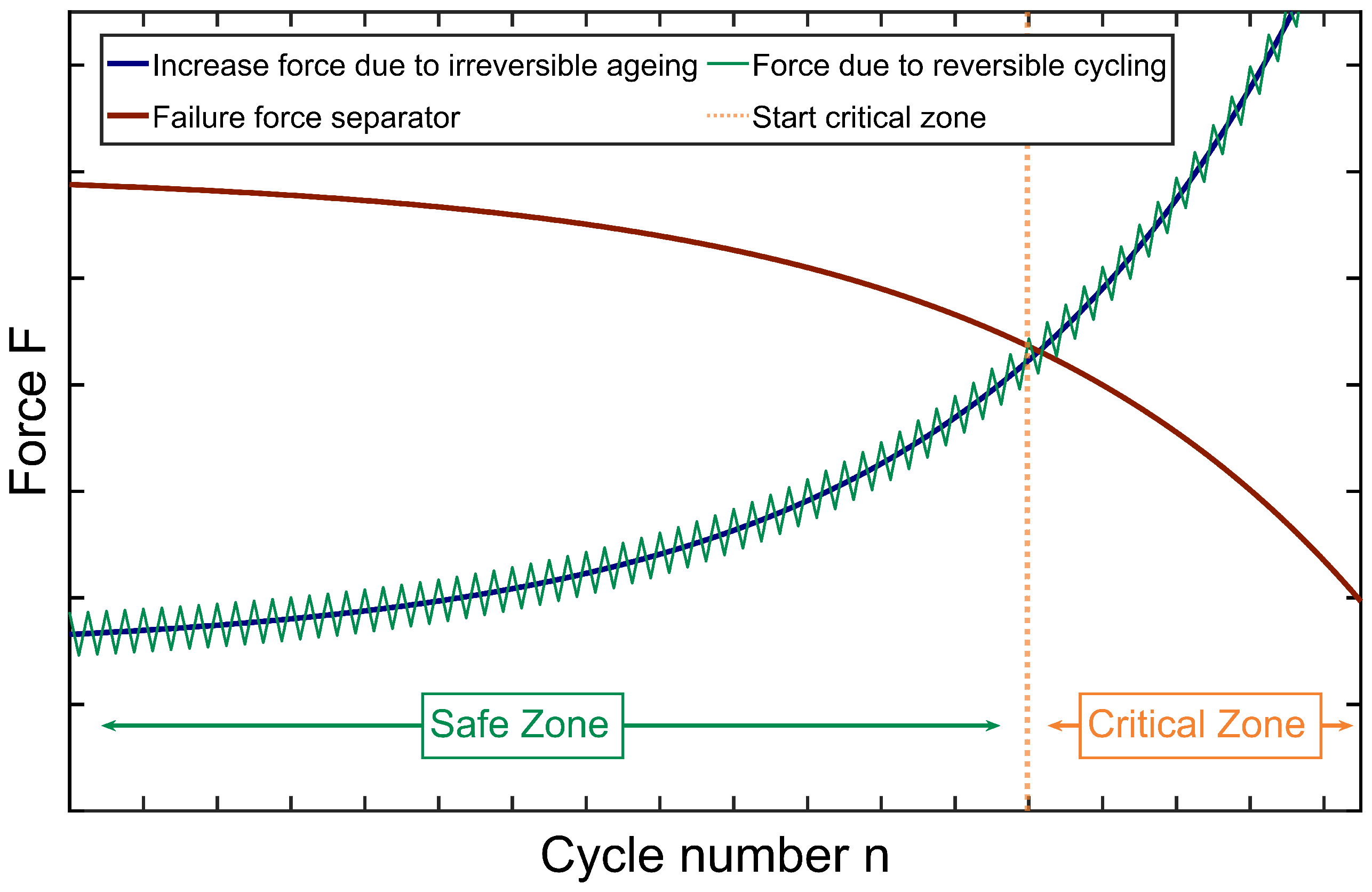

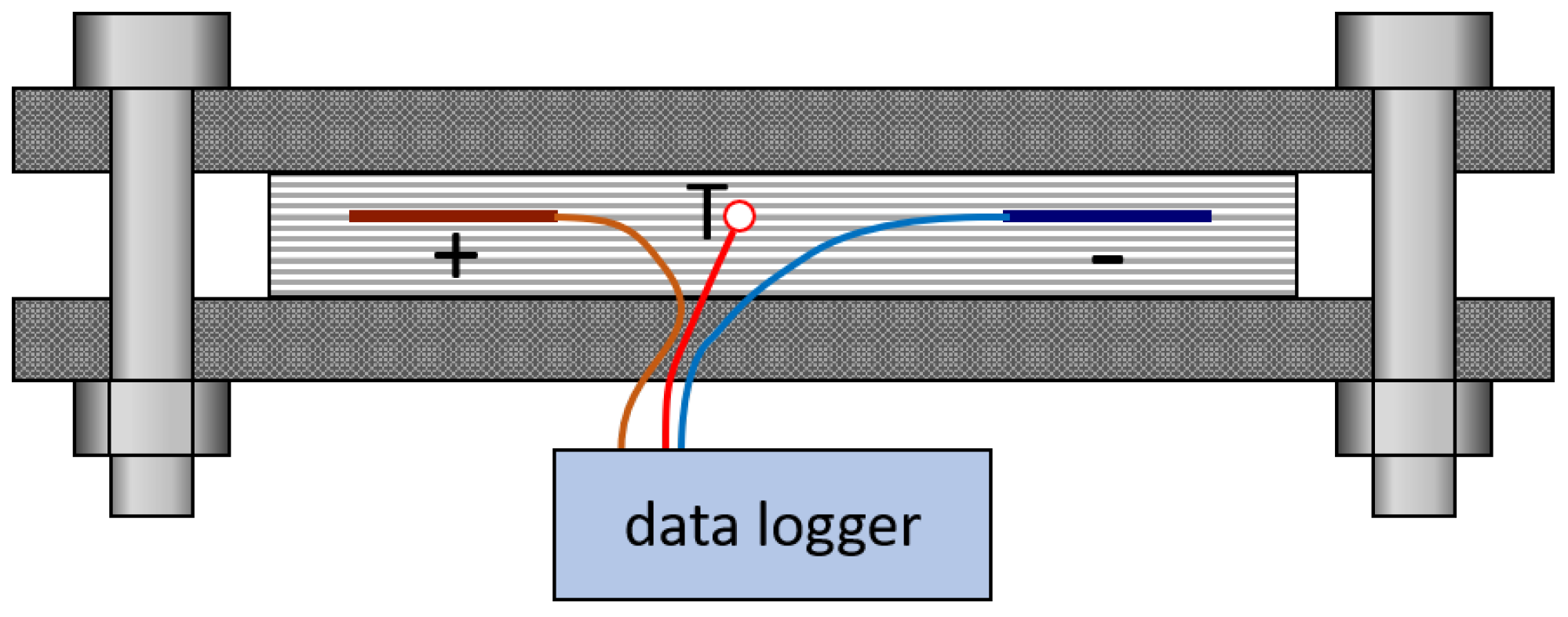
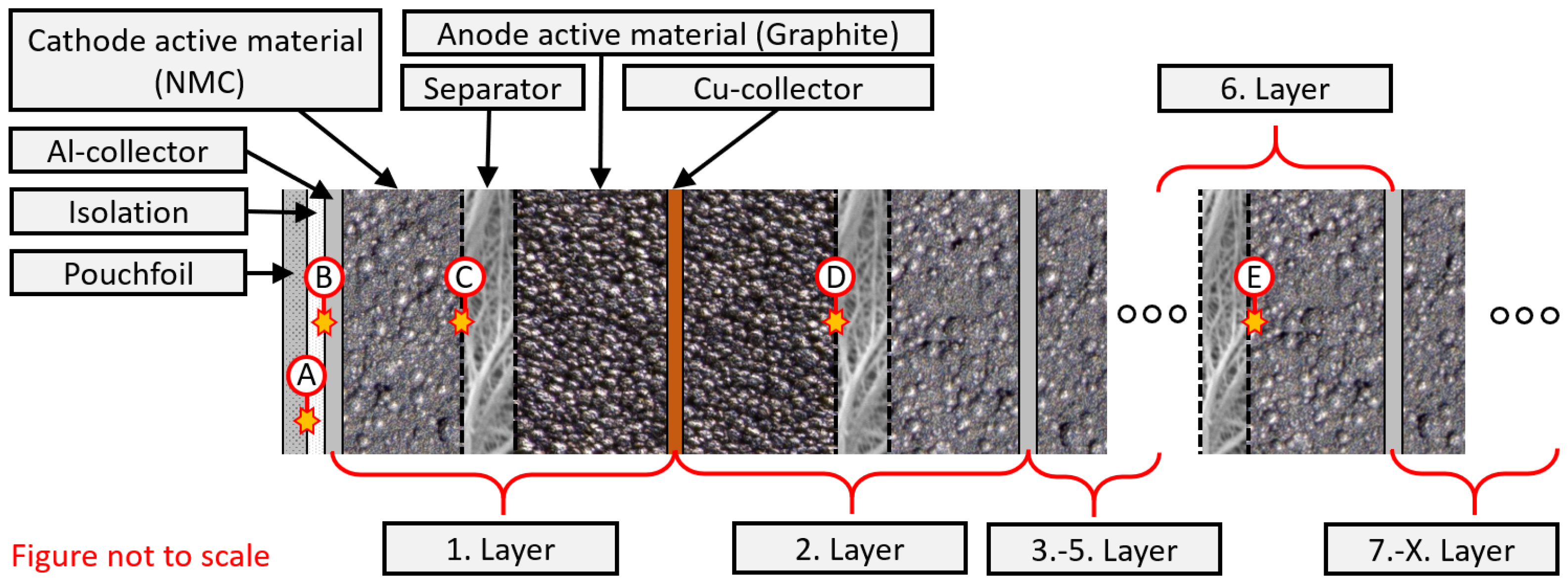

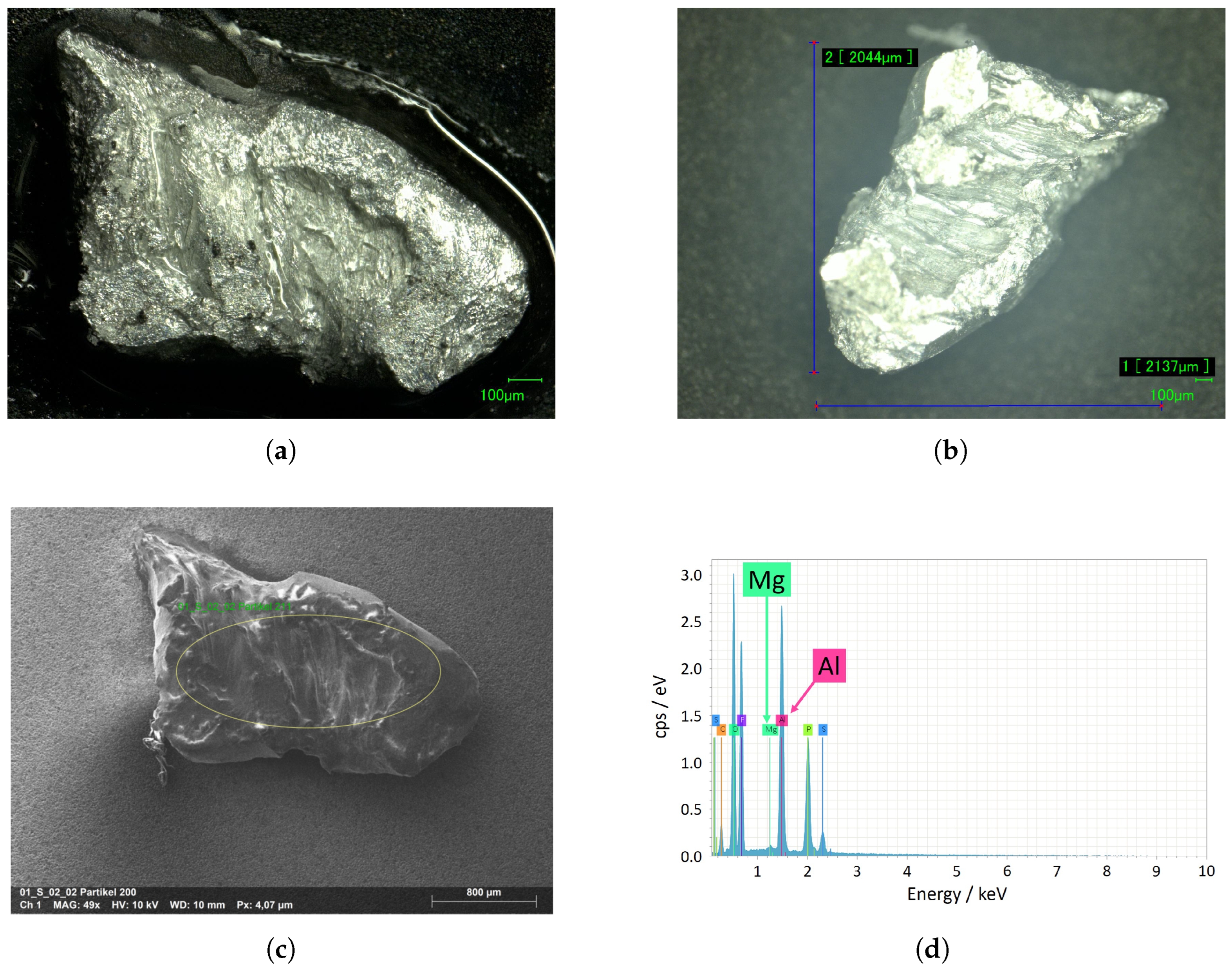
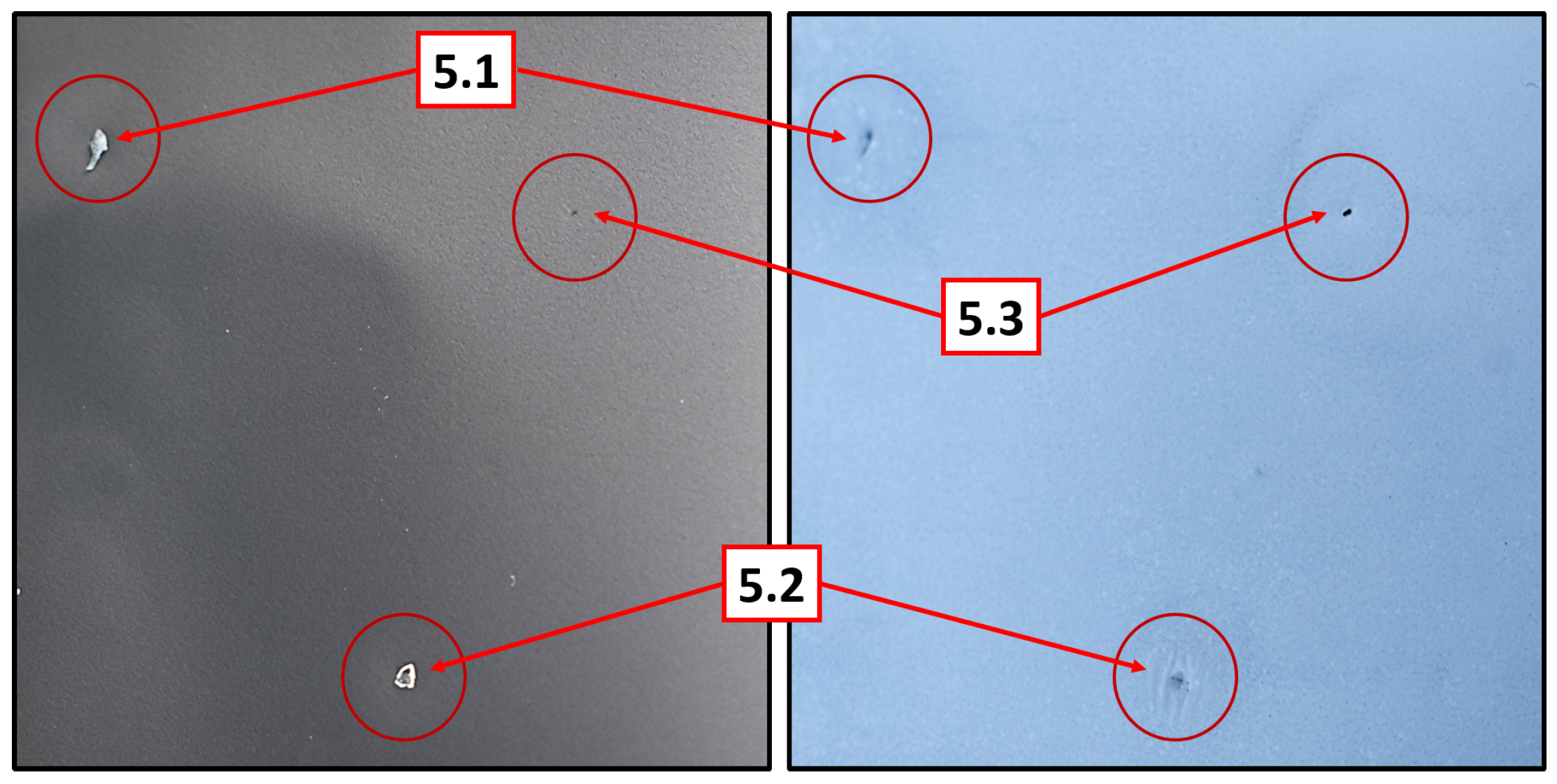
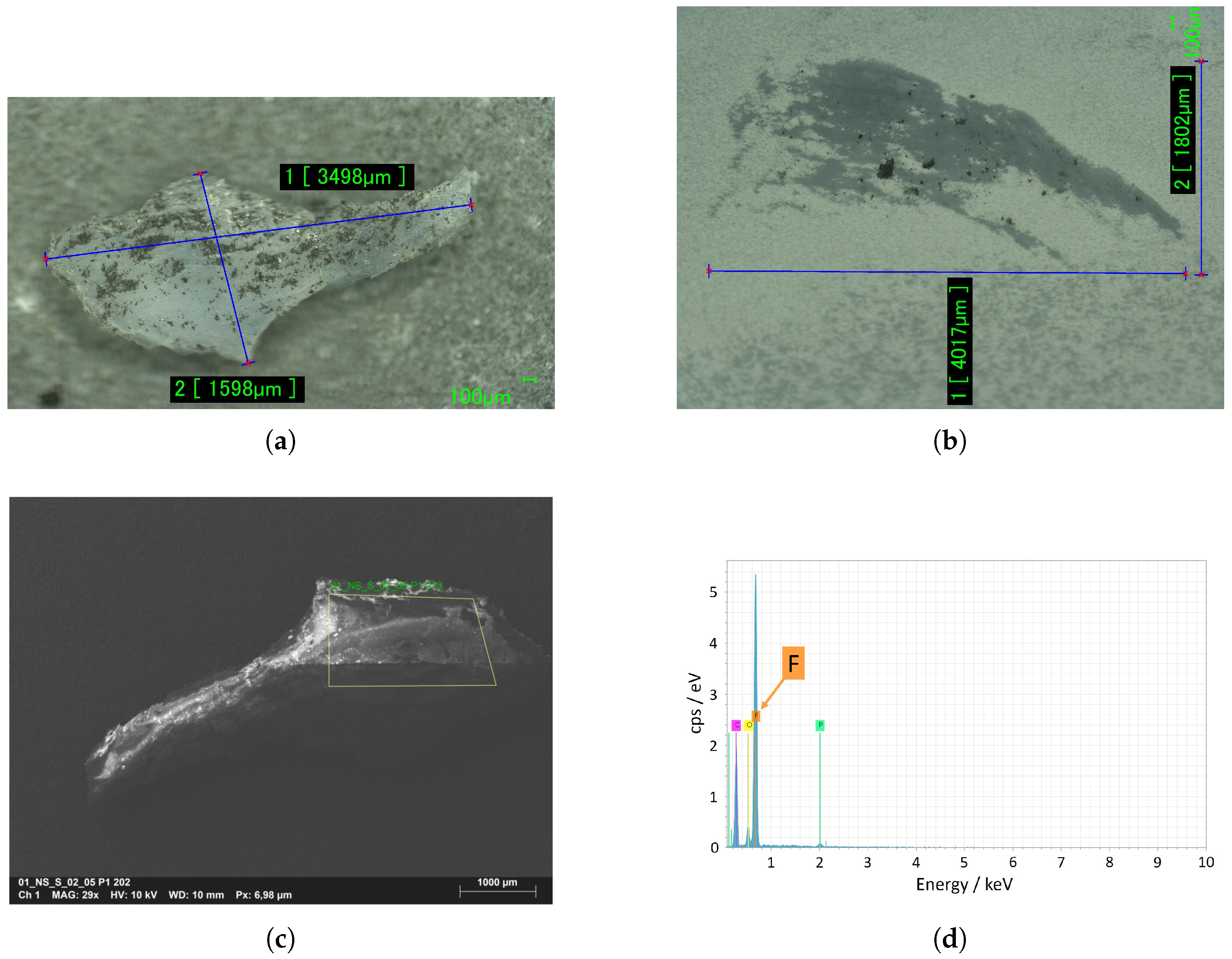



| Cell No. | 1 | 2 | 3 | 4 | 5 | 6 | |||||
| Particle No. | 1.1 | 2.1 | 3.1 | 4.1 | 4.2 | 4.3 | 4.4 | 5.1 | 5.2 | 5.3 | 6.1 |
| No. | Areal Pressure | Intended Purpose |
|---|---|---|
| 1 | 0 MPa | Reference to prove constant voltage/no ISC |
| 2 | 0.25 MPa | Typical tension force applied to pouch cells |
| 3 | 1 MPa | Reproduction of increased tension force due to higher SOC or increased swelling force (ageing) |
| /V | 3.594 | 3.665 | 3.663 | 3.672 | 3.594 | 3.664 | 3.591 | 3.591 |
| /V | 3.594 | 3.665 | 3.663 | 3.672 | 3.595 | 3.663 | 3.591 | 3.591 |
| /V | −0.145 | 0.032 | −0.012 | 0.167 | 0.29 | −0.744 | 0.414 | 0.253 |
| Pos. | Particle between | Pos. | Particle between | ||||
|---|---|---|---|---|---|---|---|
| Ⓐ | Pouchfoil | ↔ | Isolation | Ⓓ | 2. Anode | ↔ | 2. Separator |
| Ⓑ | Isolation | ↔ | 1. Al-collector | Ⓔ | 6. Separator | ↔ | 6. Cathode |
| Ⓒ | 1. Cathode | ↔ | 1. Separator | ||||
| Cell | Particle | Image | In-Situ Visibility | Particle Location | Size (w × l) | Material (Assumption) | Risk Level |
|---|---|---|---|---|---|---|---|
| 1 | 1.1 |  | Medium | Ⓐ | 0.5 × 0.85 mm | Polymer (Separator) | Low |
| 2 | 2.1 |  | Medium | Ⓔ | 1.0 × 1.7 mm | Aluminium-Magnesium | High |
| 3 | 3.1 |  | Medium | Ⓓ | 1.0 × 1.5 mm | Aluminium | Medium |
| 4 | 4.1 |  | Medium | Ⓐ | 0.3 × 0.35 mm | Graphite | Low |
| 4.2 |  | Low | Ⓐ | 0.2 × 0.45mm | NMC | Low | |
| 4.3 |  | Medium | Ⓐ | 0.5 × 1.3mm | Graphite | Low | |
| 4.4 |  | Low | Ⓑ | 0.5 × 0.95mm | NMC | Low | |
| 5 | 5.1 |  | Good | Ⓒ | 1.6 × 3.5mm | Teflon | Medium |
| 5.2 |  | Medium | Ⓒ | 1.4 × 1.5mm | Iron | High | |
| 5.3 |  | Low | Ⓒ | 0.3 × 0.75mm | Graphite | Low | |
| 6 | 6.1 |  | Good | Ⓐ | 0.25 × 0.3mm | Silicon (Flux) | Low |
| No. | Name | Variation in ISC Types | Adaptabilty of ISC resistance | Locality of ISC | Adaptability of General Cell Parameter (T, SOC, SOH, etc.) | Reproducibility | Transferability to Other Cell Designs | Preparation Effort |
|---|---|---|---|---|---|---|---|---|
| ① | PCM | ++ | + | ++ | o | + | o | - |
| ② | Low-melting-point alloy | + | o | + | o | o | o | - |
| ③ | SMA | + | - | + | o | o/+ | o | - |
| ④ | Particle-BAJ | o | o/+ | o | + | o/+ | o | - |
| ⑤ | Inserting steel ball externally/blunt rod/IIISC test | - | - | o | - | o | - | + |
| ⑥ | Slots in separator and electrode material | ++ | + | o | + | + | - | - |
| ⑦ | Penetration: Ceramic nail with Ni tip | -/o | - | - | + | +/o | +/o | + |
| ⑧ | Slow penetration with small needle | -/o | -/o | o | + | + | o | o/+ |
Disclaimer/Publisher’s Note: The statements, opinions and data contained in all publications are solely those of the individual author(s) and contributor(s) and not of MDPI and/or the editor(s). MDPI and/or the editor(s) disclaim responsibility for any injury to people or property resulting from any ideas, methods, instructions or products referred to in the content. |
© 2022 by the authors. Licensee MDPI, Basel, Switzerland. This article is an open access article distributed under the terms and conditions of the Creative Commons Attribution (CC BY) license (https://creativecommons.org/licenses/by/4.0/).
Share and Cite
Grabow, J.; Klink, J.; Benger, R.; Hauer, I.; Beck, H.-P. Particle Contamination in Commercial Lithium-Ion Cells—Risk Assessment with Focus on Internal Short Circuits and Replication by Currently Discussed Trigger Methods. Batteries 2023, 9, 9. https://doi.org/10.3390/batteries9010009
Grabow J, Klink J, Benger R, Hauer I, Beck H-P. Particle Contamination in Commercial Lithium-Ion Cells—Risk Assessment with Focus on Internal Short Circuits and Replication by Currently Discussed Trigger Methods. Batteries. 2023; 9(1):9. https://doi.org/10.3390/batteries9010009
Chicago/Turabian StyleGrabow, Jens, Jacob Klink, Ralf Benger, Ines Hauer, and Hans-Peter Beck. 2023. "Particle Contamination in Commercial Lithium-Ion Cells—Risk Assessment with Focus on Internal Short Circuits and Replication by Currently Discussed Trigger Methods" Batteries 9, no. 1: 9. https://doi.org/10.3390/batteries9010009
APA StyleGrabow, J., Klink, J., Benger, R., Hauer, I., & Beck, H.-P. (2023). Particle Contamination in Commercial Lithium-Ion Cells—Risk Assessment with Focus on Internal Short Circuits and Replication by Currently Discussed Trigger Methods. Batteries, 9(1), 9. https://doi.org/10.3390/batteries9010009







